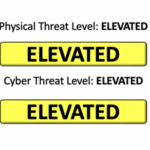
Faith-Based Daily Awareness Post 23 September 2025
Faith-Based Security Headlines
These updates are shared to help raise the situational awareness of Faith-Based organizations to best defend against and mitigate the impacts from all-hazards threats including physical security, cybersecurity, and natural disasters.
U.S. registers most outbreaks of global antisemitism in August: Watchdog report
A new report from the Combat Antisemitism Movement (CAM) found that in August there were 694 antisemitic incidents worldwide, an average of more than 22 per day representing about a 15.7 percent increase year over year. The United States recorded 162 of those incidents, more than any other country, a 13.3 percent rise from July’s total. Many of the acts (66.3 percent) were linked to anti-Israel sentiment, reflecting a continuing pattern of targeting Jewish individuals and institutions through anti-Zionist rhetoric and vandalism. The report also highlights spikes on college campuses (19 cases globally, 14 in the U.S.) in Holocaust denial and related vandalism, and examples such as swastikas at a Jewish Museum and “Death to the IDF” graffiti.
Analyst Comments: The CAM findings show a trend of antisemitic as it continues to escalate globally. The rise in incidents tied to anti-Israel rhetoric show how geopolitical tensions often spill over into local communities, fueling harassment, vandalism, and intimidation against Jewish individuals and institutions. The spike on U.S. college campuses is particularly concerning given the role of these environments in shaping public discourse and future leadership. For security and policy stakeholders, this report shows the need for stronger monitoring, proactive education initiatives, and coordination between law enforcement, campus administrators, and community leaders to address both the immediate manifestations of antisemitism and the drivers of it.
New Research Provides Benchmarks in Executive Protection
The ASIS study, based on responses from 824 security professionals, reveals that only about 28 percent of organizations have a formal executive protection (EP) policy with dedicated resources. Many others fold EP into broader security plans or activate it only when threats emerge. Organizations tend to rely more on in-house personnel (44 percent) than full outsourcing (8 percent), with a significant share using a hybrid approach. The survey also shows that EP is gaining increasing attention: roughly 70 percent of respondents said their organizations place more emphasis on EP now than two years ago, largely driven by high-profile security incidents and rising public threats to executives. In the travel security domain, the top-rated threats were terrorism, political instability, and historical violence, with typical countermeasures including 24/7 communications, intelligence, monitoring, and secure transportation. However, the research also highlights obstacles like budget constraints along with executive non-compliance.
Analyst Comments: The ASIS benchmarking report shows both progress and persistent gaps in executive protection strategies. On one hand, the growing emphasis on EP, driven by high-profile incidents and a visibly more hostile threat environment shows that organizations are beginning to treat executive security as a strategic priority rather than a reactive measure. However, the fact that fewer than one-third of organizations maintain formal, resourced EP programs highlights a significant vulnerability, particularly as threats against executives continue to rise globally. The reliance on hybrid models reflects practical resource management, but the lack of incident tracking makes it difficult to evaluate effectiveness or justify budget expansion. The tension between executive non-compliance and organizational risk posture is also a notable red flag; without leadership buy-in, even well-resourced EP programs face diminished effectiveness. For security leaders, the findings suggest the need for stronger integration of EP into enterprise risk management, clearer performance metrics, and targeted executive education to overcome cultural and compliance barriers.
Left-Wing Terrorism and Political Violence in the United States: What the Data Tells Us
The CSIS brief “Left-Wing Terrorism and Political Violence in the United States: What the Data Tells Us” finds that while left-wing extremist violence remains much lower overall than right-wing or jihadist violence, it has been rising in recent years and so far in 2025 left-wing incidents have outnumbered right-wing ones for the first time in decades. The authors note that left-wing attacks tend to be less lethal, more opportunistic, and more decentralized than other forms of terrorism, often involving arson or small-scale assaults against government or law enforcement targets rather than mass casualty events. The rise in left-wing violence is largely attributable to anti-government and partisan motivations, particularly against political actors, institutions like ICE, and perceived state power. Despite their increasing frequency, left-wing attacks are constrained by factors including limited tactical sophistication, poor operational capacity, and effective counterterrorism measures already in place. The brief argues the U.S. must treat left-wing violence with seriousness while avoiding overreaction, ensuring resources and intelligence capacity address threats from across the ideological spectrum, and maintaining political leadership that consistently condemns violence from all sides.
Analyst Comments: The CSIS analysis highlights several security-focused takeaways relevant for practitioners. First, while left-wing incidents are increasing in frequency, they remain characterized by low lethality and limited tactical sophistication which distinguishes them from other extremist threats. This suggests that protective measures emphasizing early detection, local intelligence sharing, and disruption of small-scale plots are likely to remain effective. Second, the opportunistic and decentralized nature of these attacks makes them harder to anticipate through traditional hierarchical threat-mapping, underscoring the value of monitoring emerging narratives, lone-actor behaviors, and flashpoint events that may drive activity. Third, the data illustrates the importance of balanced threat assessments: over-indexing resources on one ideological category risks leaving gaps elsewhere. Finally, the findings reinforce the need for scenario planning and resilience measures that focus less on mass-casualty preparedness and more on protecting high-visibility assets, government facilities, and frontline personnel from targeted disruption or intimidation efforts.
More Faith-Based Stories
- Citronelle church burns to the ground after a car on fire crashes into it
- Dearborn Man Sentenced for Illegally Possessing Firearms after Antisemitic Tirade Against Parents and Preschoolers at Local Synagogue
- Hot Springs pastor charged for alleged sexual assault of teen church member
- Senior officials push use of Chinese language in Xinjiang and intensify focus on religion
- Historic church in rural Alberta torched during crime spree: ‘Utter devastation’
- Remarks Delivered by Special Agent in Charge Joseph Rothrock at a Press Conference Regarding the Shooting at an ICE Facility in Dallas
- Russian warplanes detected flying near Alaska again, US military says
- Countering Domestic Terrorism and Organized Political Violence
- Activists fight ICE by doxxing agency chief
- LGBTQ leaders condemn proposed FBI terrorism label for transgender Americans
- Humberto becomes a hurricane and may soon be joined by Imelda, posing a US threat
- Russia dares NATO to shoot
- Video: Workplace Safety Isn’t Optional—Are You Ready Webinar
More Security-Focused Content

The FB-ISAO’s sponsor Gate 15 publishes a daily newsletter called the SUN. Curated from their open source intelligence collection process, the SUN informs leaders and analysts with the critical news of the day and provides a holistic look at the current global, all-hazards threat environment. Ahead of the daily news cycle, the SUN allows current situational awareness into the topics that will impact your organization.


